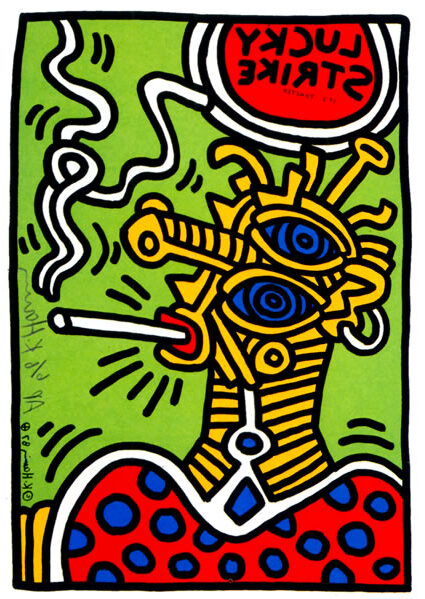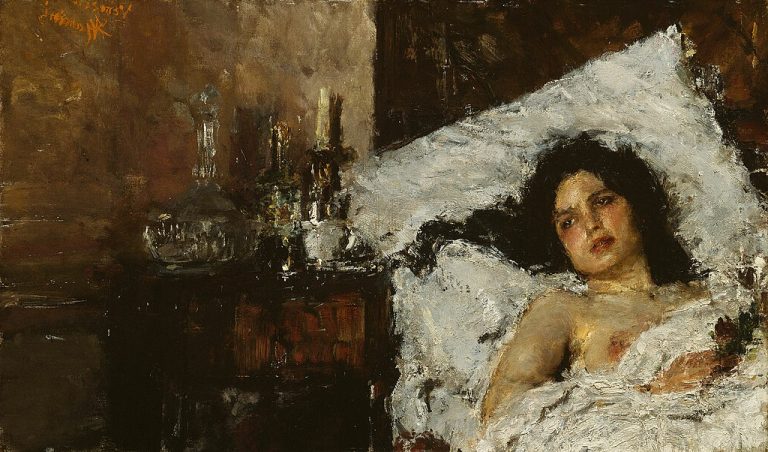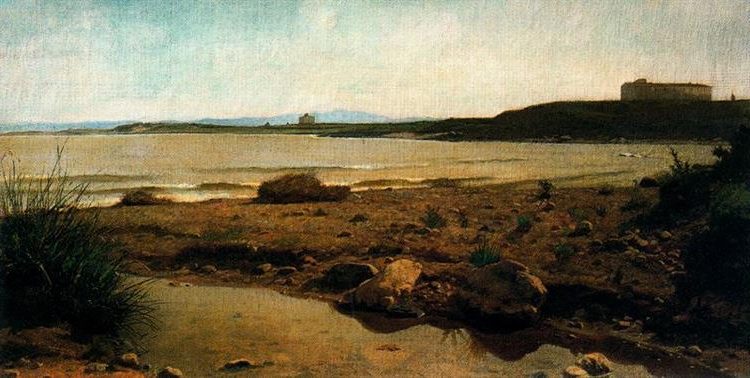Keith Haring Artwork: Exploring Vibrant Pop Art Legacy
Born: May 4, 1958, Pennsylvania, U.S.
Death: February 16, 1990 New York City, U.S.
Art Movement: Pop Art, Street art
Nationality: American
Influenced By: Dr. Seuss, Charles Schulz, and Looney Tunes
Institutions: School of Visual Arts (SVA) and The Art Institute of Pittsburgh
Keith Haring Artwork: Exploring Vibrant Pop Art Legacy
Keith Haring’s Life and Influence
Keith Haring Artwork was a renowned American artist. His work left a significant impact on modern art and social activism. His artistic journey began in Pennsylvania but truly flourished when he moved to New York City. Haring’s connections with influential artists and his commitment to AIDS awareness cemented his legacy.
Keith Haring Artwork Early Life and Education
Keith Haring was born on May 4, 1958, in Reading, Pennsylvania. From a young age, he showed an affinity for drawing, inspired by his father’s cartoons.
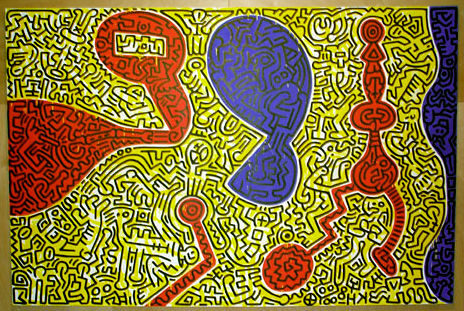
Toledo (1988) by Keith Haring
In 1978, Keith Haring Artwork moved to New York City to attend the School of Visual Arts. Here, Haring developed his unique style, influenced by the bustling street art scene and graffiti culture.
His New York experience enabled him to refine his artistic voice, leading to the vibrant pop art he is celebrated for today. These early years laid a strong foundation for his later work, which often featured bold lines and bright colors, becoming iconic symbols of 1980s art.
Influential Relationships
While in New York, Haring met several key figures in the art world who shaped his career. He formed a close friendship with fellow artists Jean-Michel Basquiat and Kenny Scharf. These relationships enriched his work and expanded his creative influence.
Haring also collaborated with legendary artist Andy Warhol. Together, they pushed the boundaries of pop art and increased its visibility in mainstream culture.
These interactions played an essential role in Haring’s development, allowing him to blend various artistic elements into his work. The connections he established contributed significantly to his success and lasting influence in the art community.
Activism and Legacy
Haring used his platform for activism, particularly focusing on AIDS awareness. The epidemic personally affected him, and his artwork became a vehicle for advocacy. Pieces like the “Ignorance = Fear” series aimed to promote education and compassion regarding the disease.

Ignorance = Fear (1989) by Keith Harin
In 1987, he founded the Keith Haring Foundation to support children’s programs and AIDS organizations. Haring’s artwork was not just limited to galleries. Public murals in New York City became spaces for social commentary. He also participated in prestigious exhibitions like the Whitney Biennial and Documenta.
Keith Haring’s influence continues, with his work remaining relevant and inspiring new generations of artists.
Artistic Style and Development
Keith Haring artwork is known for its vibrant colors and bold lines, capturing the dynamic nature of street culture and pop art. His work often uses recognizable symbols and motifs to communicate messages about social and political issues.
Formative Years in Art
Keith Haring Artwork began his journey in art during his childhood in Pennsylvania. Influenced by his father’s cartoons and the visuals in pop culture, he was drawn to creating. In 1978, Haring moved to New York City to study at the School of Visual Arts. Here, he developed a strong interest in graffiti, which became a significant part of his artistic expression.


His work during these early years was heavily shaped by the vibrant street art scene in New York. The experiences and opportunities in the city helped him blend traditional and commercial art forms with street culture elements. His exposure to different artists and styles at the School of Visual Arts further broadened his artistic horizons.
Identifiable Motifs
Keith Haring artwork is filled with recurring motifs that became his signature. Barking dogs, radiant babies, and dancing figures are some of the most recognizable symbols in his work. These images are combined with bold lines and bright colors to create pieces that are both accessible and impactful.
The motifs Haring used were not just decorative; they carried deep meanings. For instance, the radiant baby often symbolized innocence and joy. The barking dog could represent authority or aggression. These symbols helped convey complex ideas in a manner that was easy to understand and remember, allowing his messages to resonate with a wide audience.
Integration of Socio-Political Themes
Keith Haring Artwork is a platform to address major social issues of his time. His works often featured themes related to AIDS awareness, LGBTQ+ rights, and social justice. His public murals became powerful statements against issues like drug abuse and nuclear war.
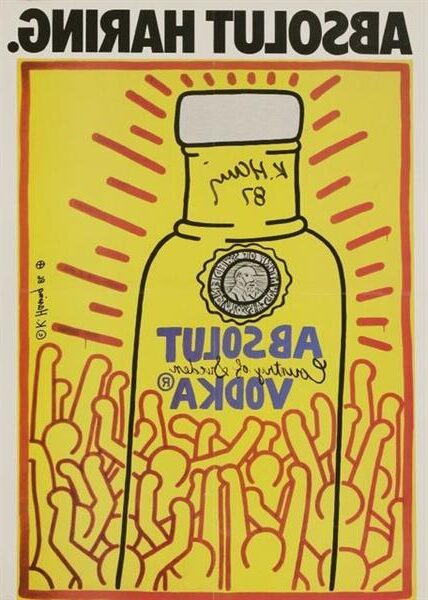
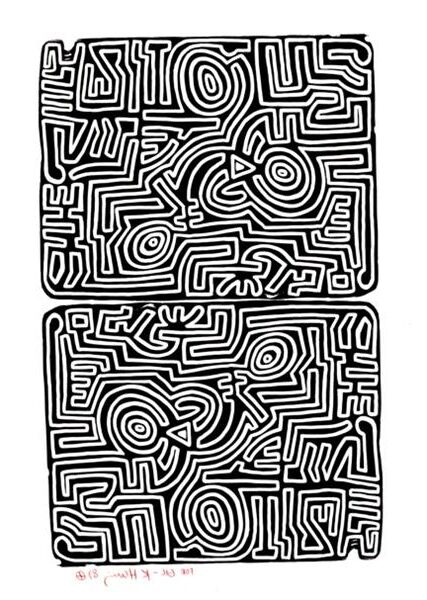
By integrating these themes, Haring positioned himself as not just an artist but a social activist. His commitment to challenging societal norms through his art was evident in how he chose public spaces for his work. These spaces allowed him to reach people outside traditional gallery settings, further emphasizing the public and universal nature of his messages.
Significant Works and Collaborations
Keith Haring was a pioneering street artist whose influence is felt throughout many mural projects and collaborations. This section focuses on some of Haring’s most notable works, including his Pop Shop initiative, famous murals, and key collaborations with other artists.
Pop Shop Initiative
Keith Haring launched the Pop Shop in New York City in 1986 to make his art accessible to a broad audience. The Pop Shop offered a range of affordable items featuring his art, like posters, buttons, and t-shirts, democratizing what was traditionally seen only in galleries.
Haring used bold lines and vibrant colors on products to convey social messages and celebrate themes like love and unity. The shop attracted diverse visitors, from art enthusiasts to casual passersby, expanding his reach.
Despite its commercial setup, he used the Pop Shop as a tool for education and advocacy, challenging societal norms. His move to bring art to the masses reshaped how people interacted with contemporary art.
Iconic Murals
Haring’s murals have become iconic pieces of public art. “Crack is Wack” is one such mural, painted on a handball court in East Harlem. It addressed the crack cocaine epidemic affecting New York City in the 1980s.

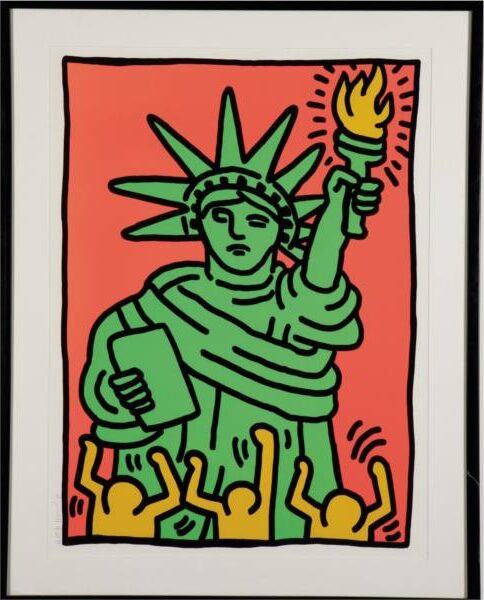
Another significant mural is “Free South Africa.” It confronted the issues of apartheid, using Haring’s trademark characters to depict themes of struggle and resistance.
The Berlin Wall is home to another remarkable piece by Haring. Painted in 1986, the mural stretched over 300 meters, making a powerful political statement about division and unity.
Haring’s murals are unique for their public accessibility, offering art that everyone can engage with, regardless of their background.
Collaborative Projects
Keith Haring Artwork often worked with other influential figures. His collaboration with Jean-Michel Basquiat resulted in vibrant artworks that fused their distinct styles, challenging traditional art forms.
“Andy Mouse,” another partnership, combined Haring’s love for Disney and admiration for Andy Warhol, showcasing his playful style.
Haring also collaborated on the Houston Bowery Wall, where his figures joined Warhol’s pop culture prints.
Each project fused creativity with activism. His collaborations highlighted his commitment to breaking barriers in art and society, embedding his legacy in history.
Impact on Art and Culture
Keith Haring’s artwork left an indelible mark on modern art and popular culture. He skillfully merged street art with graffiti art into the mainstream, influencing countless artists. Haring’s creative vision was deeply rooted in the vibrant art movement of the 1980s.
Redefining Modern Art
Haring broke new ground by bridging street and high art, transforming urban spaces into vast canvases. His energetic lines and bright colors became identifiable symbols, influencing the direction of modern art. This style combined elements of graffiti art and Pop Art.
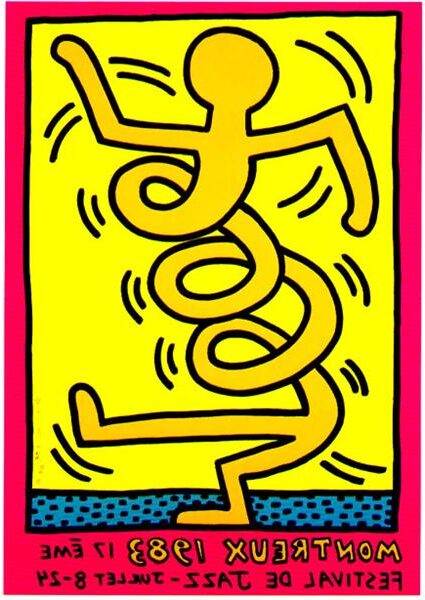
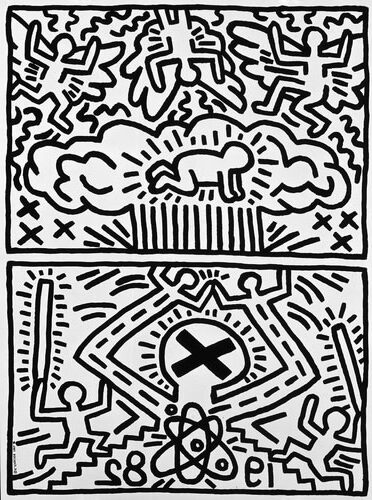
His work was not confined to galleries. Haring’s extensive use of public spaces, such as subways, democratized art, making it accessible. This approach redefined the relationship between artists and their audience. Club 57, a key venue of the era ,became a hub for his collaborations and creativity.
In doing so, Haring opened the door for other artists to challenge conventional boundaries. By rejecting the elitism often associated with fine art, he shaped a new path for the commercial art world.
Influence on Future Generations
Keith Haring artwork influence extends beyond his lifetime through the Keith Haring Foundation, which supports children’s education and HIV/AIDS prevention. His activism and art continue to inspire emerging artists who draw from his vivid style and bold social commentary.
Haring’s work remains relevant in contemporary discussions about street art and popular culture. His ability to tackle complex themes such as love, birth, and death, using accessible visual language, empowers new generations to explore societal issues through art.
His legacy is celebrated in exhibitions worldwide, impacting not just art, but society as a whole. Future artists cite him as a pivotal figure, proving that art can push for social change and break traditional constraints.
Legacy and Commemoration
Keith Haring art and activism continue to resonate today. His distinctive style and social messages are still celebrated and interpreted in various forms, ensuring that his influence endures. His efforts in raising awareness about major issues of his time add depth to his artistic legacy.
Continued Relevance
Haring’s work manages to stay relevant by addressing universal themes. He tackled issues like the AIDS epidemic and apartheid with bold visuals and clear messages. Haring also responded to the crack epidemic with socially conscious pieces that urged awareness and change. His art was more than visual—it was a call to action.
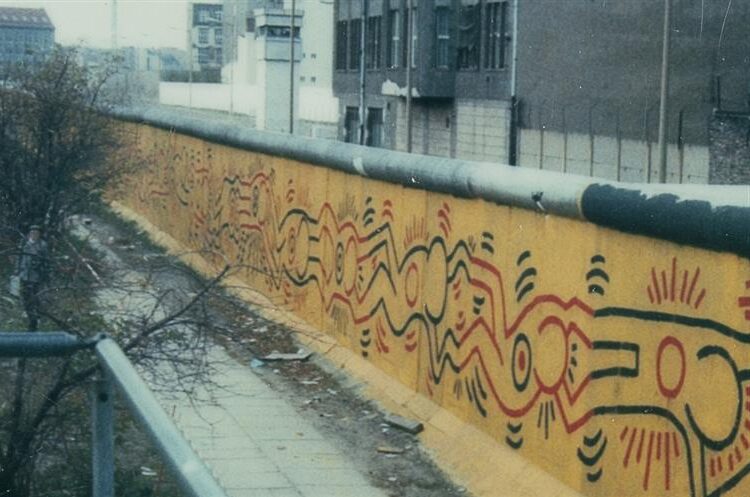
Berlin Mural (1986) by Keith Haring Artwork
Institutions like the Museum of Pop Culture celebrate his legacy with exhibitions that bring his art and activism to new generations. Pieces like “Monkey Puzzle” or his striking subway collages exemplify his impactful use of public spaces. His collaborations, including work with brands like Absolut Vodka, show his adaptability and reach.
Representations in Media
Haring’s art is featured in numerous films, documentaries, and books. He has become a symbol of 1980s New York street culture. Films and literature exploring that era often include his work as a marker of cultural identity. His visual language has transcended his original pieces, appearing in varied media including fashion and digital art.
Major projects like his murals capture both energy and a sense of urgency, giving a glimpse into his world and the issues he championed. His art communicates messages that are still poignant, ensuring his contribution to both culture and art remain influential.
Frequently Asked Questions
Keith Haring’s artwork is recognized for its bold lines and vibrant colors. His pieces often tackle social issues like AIDS, capitalism, and more. They are celebrated for their unique style and cultural impact.
What is the significance behind Keith Haring’s artwork?
Keith Haring’s work is significant because it aims to make art accessible to everyone. His pieces often address social issues and encourage activism. By using public spaces for his work, he brought attention to causes like AIDS awareness and social justice.
How can you identify an original Keith Haring piece?
Original Keith Haring artworks can be identified by his distinct use of bright colors and bold lines. Many of his pieces feature iconic symbols like the radiant baby and barking dog. Additionally, authenticated works usually come with provenance from recognized art dealers or institutions.
What themes are commonly found in Keith Haring’s drawings and murals?
Common themes in Haring’s work include social activism, love, birth, death, and unity. He frequently used his art to comment on politics and social issues, aiming to inspire change and foster awareness. His drawings reflect a deep commitment to addressing societal challenges.
What is the range of values for Keith Haring’s original artwork at auction?
The value of Keith Haring’s pieces can vary widely. Some smaller works might sell for thousands, while more prominent pieces have reached millions at auction. The specific value depends on factors like the artwork’s size, historical significance, and condition.
How has Keith Haring’s contribution to pop art influenced modern artists?
Keith Haring significantly influenced modern artists by merging pop culture with social activism. His bold style and use of street art techniques have inspired countless artists to blend art with message-driven content. Haring’s legacy endures in contemporary works focusing on activism and public engagement.
What are some key characteristics that distinguish Keith Haring’s style?
Keith Haring’s style is characterized by vibrant colors, thick outlines, and dynamic, kinetic figures. His work often incorporates repetitive symbols like hearts, babies, and animals. The simplicity yet depth in his art makes it immediately recognizable and enduringly impactful.

